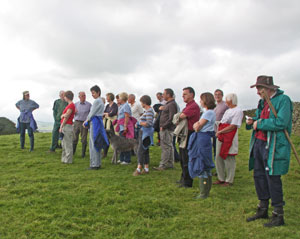


Yorkshire fog, bent, and dog’s tail ? What are they? They are all types of grass, and just three of the very many varieties of grasses, sedges and wild flowers we were shown in our walk up to Long Preston moor with Edward Wilkinson, local Farmer and Lecturer in Landscape Management.
Twenty one interested walkers accompanied Edward on what turned out to be a lovely sunny afternoon. They were fascinated to discover that this small area of moorland was home to about 50 to 60 species of plant; including about 20 different grasses and about 10 sedges.
A Walk on Long Preston Moor
was held on Saturday 13th September 2008
to discover the landscape delights on our doorstep.
Grass of Parnassus
Edward explained how the soils were formed from the three layers of rock which make up our landscape. At the base, pre-
Further up, however, the uncultivated moorland edge has a broad range of vegetation because the soil types meet and in one area a limestone ‘uprising’ gives rise to an alkaline spring which encourages plants such as Solomon’s seal, and in the early summer, primrose. It was fascinating to have a walk in the company of one who works the landscape and has come to know its grasses and wildflowers so well. Thank you, Edward, for a thoroughly enjoyable walk. We will now see the landscape with new eyes when we walk up to the moor.


